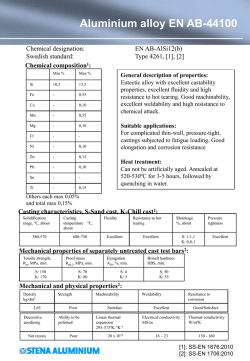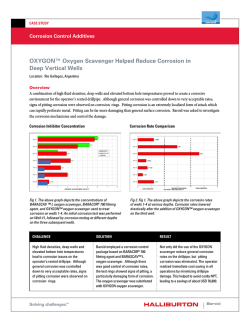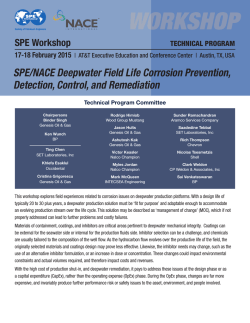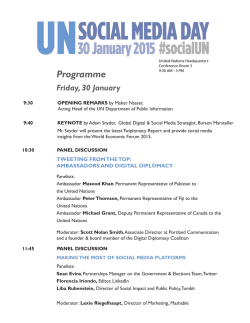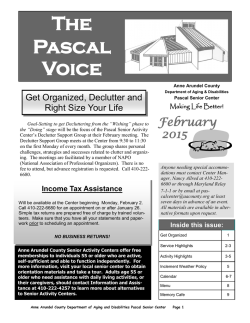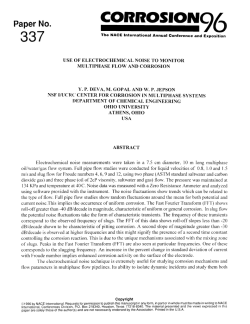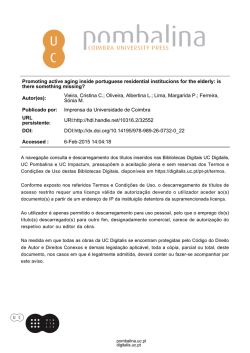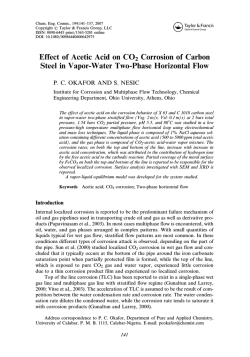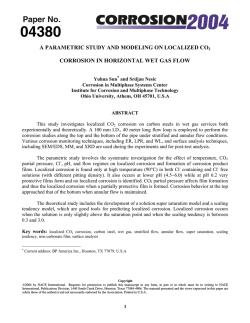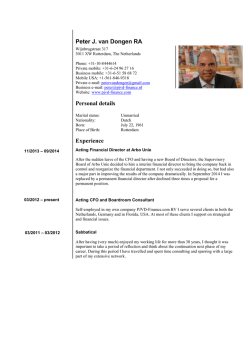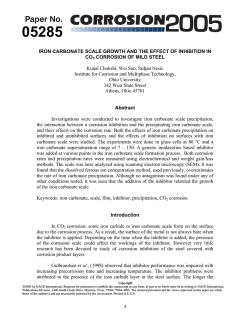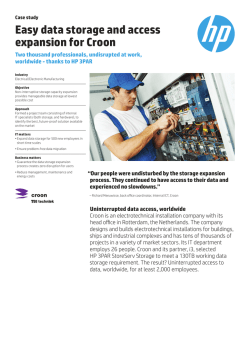
Conference timetable - Managing Aging Plants
4 Preliminary Conference Timetable Please note that this conference timetable is a preliminary version and that the organizers reserve the right to make alterations. The final program will be distributed at the conference. Tuesday, March 3rd, 2015 Plenaries – Room 7a/7b 9:00 am Opening & welcome address John Aller, Executive Director, Materials Technology Institute, USA Thijs Elshof, CEO, KCI Publishing, The Netherlands www.managingagingplants.com 9:10 am Neil Henry, Principal Materials Consultant, ABB Limited, UK Managing Aging Plants – Ten years after Why has this theme become important within Europe and what are the implications? Why does it need to be addressed? 9:40 am Pol Hoorelbeke, Deputy Senior Vice President HSE TOTAL Refining & Chemicals, Belgium Paul de Bruijn, Technical Integrity Advisor, HSE Division, TOTAL Refining & Chemicals, Belgium Managing aging plants from the perspective of a multi-national operator: TOTAL Refining & Chemicals 10:10 am Wim Vancauwenberghe, Director BEMAS (BElgian Maintenance ASsociation), Belgium Aging plants in North-West Europe: What can we learn from the perspective of the MORE4CORE project (Maintenance, Overall, and REpair for COmpetitiveness of the North-West European REgion?) 10:40 am Coffee Break 11:10 am Workshop A: Risk-Based Inspection – Room 7a Workshop B: Materials Selection for Replacement & Interface – Room 6 Moderator: Jacko Aerts, DSM-GMCC, The Netherlands Moderator: Christos Christoglou, Bayer Technology Services, Germany Panelists: Lena Wegrelius, Outokumpu, Sweden Michael Renner, Asset & Corrosion Management Consultancy, Germany Lars Rose, DuET, Dupont Engineering Research & Technology, Germany Panelists: Jürgen Deininger, TÜV SÜD Industrie Service, Germany Gert Henk Wijnants, Stork, The Netherlands Jarkko Räty, Service Solutions, Metso, Finland John Aller, Materials Technology Institute, USA In the Risk-Based Inspection (RBI) Workshop we will look at how this process can lead to increases in plant reliability and availability. RBI examines equipment such as heat exchangers, pressure vessels, piping and pressure relief devices in industrial/process plants and ranks them according to risk of failure. Its use allows us to prioritize and schedule inspections based on the probability that there will be materials losses (and the consequence these will have for Health, Safety and Environment), and production losses. It proceeds with mitigation activities in order to minimize unexpected failures and planned downtime. It is therefore an essential tool in the search for reaching operational excellence. In a series of short presentations we will highlight how this Asset Performance Management tool is used to optimize the extent and intervals of inspections, based on site-acceptable risk levels and operating limits, whilst, at the same time, mitigating risks as appropriate. RBI will be addressed in the following settings: · Chemical and oil & gas process industry, both upstream and downstream · Refineries · Non-continuous / batch production process industries · he health care industry · Power plants The possibilities of cost reduction through the application of RBI will be presented. The current status of regulations with regard to RIMAP and European standards will be discussed. Through audience participation and open discussion we will attempt to provide ideas, suggestions or solutions for some of the challenges with which the audience is faced. When replacing old equipment in a plant, a like-for-like replacement often seems the obvious choice to be carried out: “The previous piece of equipment lasted a long time so it must have been good”. It can, nevertheless, be questioned whether this is indeed a true philosophy and whether this is the optimal strategy. A thorough analysis of the root cause of failure could shed light on future options. It might be, for example, that the operational conditions have changed, which may require a reassessment of the materials selection process. Moreover, like-for-like replacement could be seen as a lost opportunity to improve future asset performance. Michael Renner will introduce some Asset Integrity Management concepts which have been successfully applied in many industries dealing with hazardous chemicals, especially in aging plants. These concepts also include the analysis of the potential damage mechanisms and failure modes under complex chemical & physical production conditions. These conditions demand optimized materials selection, and replacement projects require clear materials recommendations to enable safe and reliable asset performances in the future. When a replacement project has to be handled, the question should always be asked: what is the trigger causing the need for replacement? Is it aging after a very uneventful service life, a mechanical failure not covered by the design, or equipment failure caused by corrosion or other damage mechanisms? Michael Renner will briefly outline the potential impact parameters of corrosion or other materials degradation systems for a Root Cause Failure analysis with the aim of determining an optimal value-added materials selection, which addresses the economical but reliable resolution for the event and which prevents its reoccurrence. Lena Wegrelius: The reason for exchanging equipment is typically either wear, corrosion or other such material related failures. However, the refurbishment or replacement of aged chemical plant equipment provides an opportunity to optimize material selection with regard to overall life cycle and maintenance costs as well as to improve the sustainability footprint of the equipment and plant. A few examples of improved life cycle costing, when changing from carbon steel to stainless steel will be shown. Also the consequences of such a material shift with regard to the improvement in sustainability footprints will be shown. In his presentation, Lars Rose from DuPont De Nemours will focus on the material challenges faced by engineers attempting to replace or renew equipment. This will include issues such as upgraded regulatory requirements, changes in operational permits, issues with vanishing suppliers, documentation as it was decades ago, and alloys that seem to have vanished from the face of today’s operations environment. Workshop participants: Active audience discussion will be encouraged throughout the workshop so please bring some slides with you to the workshop (a maximum of four), if you wish. 12:30 am Lunch www.managingagingplants.com 13:30 pm Paper Session A – Room 7a Paper Session B – Room 6 13:30 pm Management of aged equipment lacking documentation E. Chant, Becht Engineering, USA Life-time assessment of materials under high-temperature corrosion conditions M. Schütze, A. Naji, M. Röhrig, and G. Schmidt, DECHEMA Forschungsinstitut, Germany 13:55 pm The use of fitness for service assessments in aging plants P. Schreurs, Sintra Engineering, The Netherlands Aging plants: a challenge for on-site metal analysis W. Sanders, Oxford Instruments Analytical, Germany 14:20 pm Lifetime extension projects at DSM J. Aerts, DSM, The Netherlands Atlas of Microstructures: a valuable tool for the assessment of the aging of materials E. Berghof-Hasselbächer, M. Schütze, M. Galetz,R. Durham, G. Schmidt, and J.J. Hoffman, DECHEMA Forschungsinstitut, Germany 14:45 pm Coffee Break 15:15 pm Workshop A: The role of Safety Culture and Safety Leadership in Managing Aging Plants – Room 7a Workshop: Schmidt+ Clemens, Steam reformer furnaces – Room 6 Leader: Sander Zwanikken, AdviSafe Risk Management, The Netherlands Objectives: The workshop is focused on gaining an understanding of the role of safety culture in managing aging plants, and a better understanding of safety culture. In addition, an overview will be provided of available practical tools to improve safety culture within your organization and you will practice with the use of some of the tools. The underlying objective is to inspire you to start or continue demonstrating safety leadership and provide a safe and healthy working environment for your employees, also in aging plants. Interactive, fun and inspiring In this workshop participants will practice with concrete exercises and real-life dilemmas. You will learn how you can demonstrate safety leadership and how you can work towards more pro-active safety culture in your organization related to managing aging plants. The workshop is inspired by the Hearts & Minds toolbox of Shell, developed by Shell and the University of Leiden in The Netherlands. The following subjects will be covered either in plenary or in subgroups: • Understanding your culture –what is the level of safety culture maturity in my own organization? • How to improve safety leadership in my own organization • Creating safety awareness • Improving supervision and managing mistakes and violations • The Human Factor: risk or essential for success? • Change management, where to start? 5 17:30 pm Ending Moderator: Dietlinde Jakobi, Schmidt + Clemens GmbH + Co. KG, Germany Panelists: Rob Gommans, MCC Materials and Corrosion Consultants v.o.f Pedro Imizcoz, Schmidt + Clemens Group Barry Fisher, Quest Integrity Group Val Fowler, Magnetische Prüfanlagen GmbH Malcolm Wass, SafeRad Ltd. Steam reformer units form the heart of ammonia, hydrogen and methanol production. For economic reasons, but mainly because of maintaining high levels of safety, reliability and structural integrity, end-users want to use state-of-the-art materials and inspection strategies for their reformer catalyst tubes and outlet components. An industry expert in the field of inspection techniques and typical damage mechanisms (Rob Gommans) will give a short introduction followed by a presentation on high-temperature materials and welding procedures for aged alloys (Pedro Imizcoz). The possibility of close proximity radiography will be introduced briefly (Malcolm Wass) – a new technology which is expected to accelerate maintenance & construction programmes. This steam reformer workshop will cover also aspects like inspection techniques (Val Fowler) and reformer lifecycle management (Barry Fisher). The interactions of the participants and the discussions with the industry experts shall improve the knowledge of turnaround requirements, increase the plant efficiency and help to achieve the operational, safety and reliability goals. 6 Preliminary Conference Timetable Wednesday, March 4th, 2015 www.managingagingplants.com Plenaries – Room 7a Plenaries – Room 6 9:00 am John Wintle, Consultant Engineer, TWI, UK Plant aging and the link to asset management Dale F. Hoffman, Director of Maintenance Improvement, Cristal, USA Risk-based asset integrity program: the journet 9:30 am Fulvio Caldelari, Risk Engineering, Practice Leader Energy for Global Corporate in EMEA, Zurich, Switzerland An insurer’s perspective on managing aging plants Stuart Pointer, Team Leader Mechanical Engineering , HSE, UK Managing plant aging: The approach taken by the Great Britain COMAH Competent Authority 10:00 am Thomas Anlahr, Fraunhofer Institute for Material Flow and Logistics, Germany Industry 4.0: Hype or opportunity? Gerhard Holtmann, Head of the Division of Pressure Equipment, TÜV Austria Managing aging plants: perspective of an inspection body 10:30 am Coffee break 11:00 am Paper Session A – Room 7a Paper Session B – Room 7b Paper Session C – Room 6 11:00 am How much of your aging plant is out of control? George Buckbee, Metso Automation, UK Improving the degradation mechanism studies Asset management solutions to improve value realiability, for ageing plants improve plant safety, and achieve cost savings in aging plants. Rob Gommans, Materials & Corrosion Consultants, M. Gore, Pentair, Germany The Netherlands 11:25 am Sealing aging equipment H. Dekker, Chesterton International, Germany Managing aging valves: valve conditioning monitoring R. Simpson and M. Billington, Score Diagnostics Limited, UK Decreasing the need for maintenance with high performance alloys T.Sterneland, E. Stark, and D. Reuithe, Outokumpu, Finland 11:50 am Optimizing valve maintenance using condition analysis J. Raty, Metso Automation, Finland Managing pressure safety in aging plants R.P. Bours, FIKE Europe, Belgium A known risk is a calculable risk. You have to know your assets B. Kappelmann, DNV GL, Germany 12:15 pm Thermo-hydraulic simulation and estimation of lifetime consumption A. Woitalka, R. Hölzl, P. Freko, and A. Lehmacher, Linde AG – Engineering Division, Germany Degradation mechanisms and lifetime aspects of aluminium plate fin heat exchangers R. Hölzl and H. Köpf, Linde AG – Engineering Division, Germany Supertight bolted joints – a way to minimize hot work and shut down periods T. Eriksen, Freudenberg, Oil & Gas Technologies, Norway 12:45 pm Experience with corrosion in the chemical industry H. Leonhard and G. Grötsch, TÜV Süd Chemie Service GmbH, Germany Control of volatile organic compounds: leak A detection and repair (LDAR) program. Dos-Santos, Bureau Veritas, Germany NDT technologies in industrial field service J. Nehring, Bureau Veritas, Germany Closing the recycling loop: Up-cycling of end-of-life fluoroplastics T. Schwalm, Dyneon, Germany 13:15 pm Lunch 14:15 pm Workshop A: Fitness-for-Service – Room 7a Workshop B: Corrosion under Insulation – Room 7b Moderator: Neil Henry, Principal Consultant, ABB Limited, UK Moderator: Michael Renner, Asset & Corrosion Management Consultancy, Germany Panelists: John Hallett, Growhow, Chester, UK John Sharples, AMEC, UK Bernard McGrath, AMEC, UK John Wintle, TWI, UK Panelists: Dr. Stefan Winnik, Director, SW Materials and Corrosion Ltd., UK Gerianne van Ravels, Corrosion Engineer, AkzoNobel, The Netherlands Knuth Schweier, Head of Corrosion & Inspection Management, Bayer Technology Services, Germany www.managingagingplants.com Fitness-for-Service is a multi-disciplinary approach to determine whether structural components are fit for continued operation and service for a desired length of time into the future, and when they need to be replaced. The equipment may contain flaws, have sustained damage, or have aged so that it cannot be evaluated by use of the original construction codes. Today there is comprehensive consensus on industry recommended practices that can be used to analyze, evaluate, and monitor equipment for continued operation but these practices may pose challenges and uncertainties. This workshop will look to address various Fitness-for-Service challenges. The panelists will provide a personal account of how Fitness-for-Service principles effect their everyday working lives. In this way they will open up a discussion with the audience to see how Fitness-for-Service principles can be more effectively applied in facilities to provide solutions for both now and in the future. 15:45 pm Ending ceremony Highlights of the workshop will be as follows: What is CUI? What type of assets are involved in the hydrocarbon & chemical processing industry? • Fixed equipment (reactors, vessels, columns, etc.) • Piping (including prefabricated piping) • Tanks Potential threats associated with CUI State-of-the-art mitigation strategies & methods • Design • Corrosion prevention technology • Inspection The audience will also be encouraged to pose own company challenges, which will be addressed in the contect of knowledge sharing and experience exchange. Workshop C: Plastic Materials in Corrosive Environments – Room 6 Moderators: Karin Jacobson (Research Leader), and Daniel Ejdeholm (Senior Researcher), Polymeric Materials in Corrosive Environments, Swerea KIMAB, Sweden The workshop will be organised by the polymer R&D group at Swerea KIMAB (former Swedish Corrosion Institute). The workshop will be divided into a theoretical part focusing on the causes for service life limitations for polymeric materials in corrosive environments, and a more practically oriented part in which we will open discussions around some representative samples extracted from different corrosive environments. The theoretical part will discuss the different type of polymeric materials that are normally used in corrosive environments and their benefits and drawbacks. The different types of corrosive environments encountered and the type of degradation mechanisms that they can give rise to are also presented. Results from inspection of process equipment and by field and laboratory exposures of different materials in various processing streams (coupon testing) will be presented. It will be shown that from the data and knowledge achieved from this type of investigations it is possible to explain and understand failures and to predict the corrosion behaviour of plastics in different environments, also after long-term use and to determine service-life of plastic process equipment. In the practical part we will show and discuss samples which have been taken from various process equipment that have failed, have been replaced or are still in service. Experiences from our previous work have shown that valuable knowledge about the corrosion properties and the durability of plastics and rubber in different applications under practical conditions may be achieved by investigating these samples. Another important area is welding in process equipment after exposure to chemicals during service. This is a frequently encountered problem among end users of plastic process equipment where there are no general guidelines to rely on. Plastic welders often describe poor weldability as bubble formation, migration of “wax like” substances causing bad adhesion or sometimes the viscosity of the molten material is different, making welding difficult. Depending on the type of plastic material and the chemical environment there seem to be different reasons for the observed difficulties to weld. Problems with repair welding have been reported to occur after exposure to a large number of different media. This problem will be discussed both in the theoretical part and practical examples will be shown and discussed in the second part of the workshop. 7
© Copyright 2026

